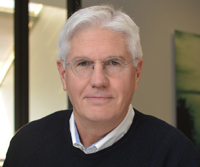Ann Handley is the Chief Content Officer of MarketingProfs and the best-selling author of two books on content marketing.
 By Stephen Shaw
By Stephen Shaw
At a time of crisis brands usually prefer to play it safe. Which is why their expressions of solidarity rarely rise above the level of greeting card sentiment. They feel they have to say something — even though it means nothing. Just another instance of marketers failing to create content that matters.
Staying relevant involves more than jumping on the social media bandwagon with platitudes and hashtags. Every brand should be on a mission to change minds, unafraid to proclaim its convictions. By creating content that matters, brands can be heard above the street noise. They can help to build consensus and accelerate social progress. And they can be the catalyst that turns a cause into a movement.
The idea of using branded content to empathize, inform and inspire is one that Ann Handley fully endorses. After all, she has been in the forefront of content marketing from the very beginning, before it even came to be recognized as a discipline of its own.
A journalist by training, Ann was a co-founder of the digital marketing news site ClickZ before selling it and moving to the online marketing training company MarketingProfs in 2002. Today that company has grown to 600 thousand subscribers. Ann is now the Chief Content Officer, overseeing all educational content.
As a long-time advocate of content marketing, Ann is a popular guest on the speaking circuit, known for her plainspoken advice and humour. She is also the best-selling author of “Everybody Writes,” and the co-author of “Content Rules”, both essential reading for content marketing professionals.
Stephen Shaw: Content marketing still seems like an immature discipline. Is it a marketing discipline in need of more discipline?
Ann Handley: There’s a lot of people doing great things with content marketing, who are pushing the boundaries. But there’s also a whole lot of people who aren’t there yet. There’s a pretty big gap between the content “haves” and the content “have-nots”. Most people do understand the benefits of content marketing. They’re just not sure where to start, or what to do. And it’s funny, because content marketing has been around, at least in its modern inception, for at least 10 years. It’s not rocket science.
Shaw: There’s no real playbook yet, is there? Is that because the subject of content marketing hasn’t worked its way into the classroom yet?
Handley: I actually think it has. I just got a text yesterday from a friend of mine whose wife teaches at the University of Iowa and she’s using “Content Rules” in her classroom. “Everybody Writes” has been adopted in a number of marketing classrooms. I’ve actually spoken at the University of Toronto here. Now that said, every professor is going to think about content marketing a little differently. My daughter goes to Northeastern University in Boston and in her marketing class the professor barely talks about content — not even about social media.
Shaw: I guess a generational turnover is required.
Handley: Yeah, sadly I think that’s probably true. But she kept saying to me, “Mom, you should talk to the class.” However, in her business writing course, they talked about content. A lot of the concepts they talked about were in my book, “Everybody Writes.”.
Shaw: Forrester Research reports that 86% of marketers feel their content marketing efforts aren’t generating business value. Why do you think that is?
Handley: At MarketingProfs we do a content marketing study every year in association with the Content Marketing Institute. That research shows there’s a pretty big gap between the people who are most successful at content marketing and the people who are less successful at it. What does that most successful group do? They develop content that maps to the buyer journey. They measure the impact in measurable ways. They have a business goal behind everything they do. Now I think we’re at an inflection point where we’re past the experimental phase. We need to start connecting our strategy to business outcomes.
Shaw: Do we need to think about content more strategically? Where the emphasis is on producing quality content?
Handley: Yeah. It’s silly to think about content marketing as a tactic. Content marketing is marketing. It’s not something that should exist in its own silo. It should always map to what your customer needs from you.
Shaw: Forrester claims that just 4% of marketers today can be classified as “content masters”. Is that because marketers struggle to become publishers?
Handley: Because they’re viewing it as a tactic when in fact it’s a strategy. Content is not a short-term tactic. And so, if your boss, your CEO, your client, whoever it may be, is looking for a quick hit, they’re going to be disappointed. I believe it delivers results over time.
Shaw: Let’s talk about strategy. I read where only 30% of companies have a formal content marketing strategy. Another 24% aren’t really committed. Fifty-six percent — this is a head-scratcher — don’t even have an ROI plan. Are businesses still looking at content marketing as an experiment? A fad, even?
Handley: Maybe. People are looking at it as “We need a YouTube channel. We need a video strategy.” That’s not a strategy. There’s still very much this mindset to talk about what we do. People don’t care about that. Marketers should be thinking about the story they want to tell. How does it map to their brand purpose? Why does the brand exist? How can we engage customers emotionally?
Shaw: We’ve gone from about 50 million blogs in 2006 to a billion. And 73% of marketers are planning to produce even more content. Have we reached peak content? How on earth do you break through that clutter?
Handley: My solution is to slow down. Be strategic and then “do less and obsess”. Create less content but obsess about the quality and value of that content. And when I say quality, I don’t mean hiring William Shakespeare to write a blog post for you. That’s not what I mean by quality. Quality to me means, does it have value in the mind of your consumer, your customer, or your prospect? Do they care about what you do? Will they miss you if you go away? That to me is quality. Your customers, your prospects, they want to know you. They don’t want marketing that feels like marketing. All that to say, we need to “do less and obsess” over what we do. The other thing I would say is that, as much as we talk about all the ways we can reach customers, sometimes the simplest thing is looking at your email newsletter in a very different way. Most brands have an email newsletter. Customers have invited you to their inbox. Can you use email more effectively? Are you really doing it as well as you should?
Shaw: Certainly, the ones I get as a consumer are too generic — they’re just promotional tools. Is that due to a disconnect between traditional brand messaging and the idea of personalized marketing?
Handley: I think there’s a big difference between “personalization” and “personable”. Being personable should be the goal, not simply “personalization”. But that’s uncomfortable for a lot of brands. And I understand that. It means being vulnerable — opening yourself to censure. I mean, I totally get it. Every two weeks I send out an email newsletter and I get letters back from a handful of people who hated something I wrote and tell me why. When you make yourself “personable”, that means as a brand you have a personality, and some people won’t like you. And that’s a hard thing for a lot of companies to accept, a lot of brands.
Shaw: What’s been the most significant trend or shift that you’re now seeing in content marketing?
Handley: We talked about one of them already, which is “doing less and obsessing”. I think the smartest companies are focusing on providing real value for their customers, for their prospects. Going back to basics, not chasing the next bright and shiny thing. That’s why I think email newsletters deserve more attention, because if you do nothing else, at least get that right. And that doesn’t require a lot of technology, it doesn’t require a lot of special skill.
Shaw: Are you seeing greater adoption and use of content hubs as a means of improving the content experience?
Handley: Yeah. Making your content more easily accessible and discoverable is a massive challenge. Content hubs really solve that challenge very nicely.
Shaw: Have we entered — I’m going to use this term loosely — a “post-literate” era, and by that, I mean where video is starting to become the predominant form of communication? And if so, what does that mean for the future of long-form content?
Handley: So, short answer, no, I don’t think we’re entering a post-literate era at all. Mary Meeker in her 2019 State of the Internet report quoted Kevin Systrom, the co-founder of Instagram who said that we’re increasingly communicating through images. So, okay, a few things. Number one, I don’t like binary thinking. I don’t like saying that the rise of Instagram and visual media means the death of text. Both can coexist nicely. I love Instagram. It’s my favorite social media platform next to Twitter. I’m not saying I don’t believe in images or I don’t love video. I do. I think it’s fantastic. It’s super strong. But that said, it doesn’t mean we have to give up on long-form content or text. And I also really don’t like the idea that we live in a world where everything is short and “snackable”, to use a word that makes me want to throw up in my mouth. I think we’re just more discerning about where we’re spending our time and attention. This isn’t a battle between images and video and text. That’s just silly. What it comes down to is, are you creating something of value and are you matching the format to the best delivery channel you can?
Shaw: Where do you see the discipline going from here? How will it evolve? What skills will be required?
Handley: I think the term “content marketing” will go away. I’d be surprised if we saw it in 10 years. It just becomes marketing – the ability to produce content that engages an audience. I don’t think content marketing is going to be living in its little corner anymore. It will be fully integrated across everything. So that’s the first thing. And secondly, I think the biggest skill you can have as a marketer is empathy. The ability to write well, speak well, the ability to communicate – you can learn all of that. But empathy is critical — to be able to see through the eyes of other people. Honestly the world needs more empathy. Companies need more empathic leaders. And so, the ability to think outside of yourself.
Shaw: That, and being curious, I suppose.
Handley: Yes, exactly. That’s another really good one too. Yes.
Shaw: So does marketing become the empathy department?
Handley: Yeah, I love that. “Empathy and Curiosity”.
Stephen Shaw is the Chief Strategy Officer of Kenna, a marketing solutions provider specializing in delivering more unified customer experiences. Stephen can be reached via e-mail at sshaw@kenna.ca.



